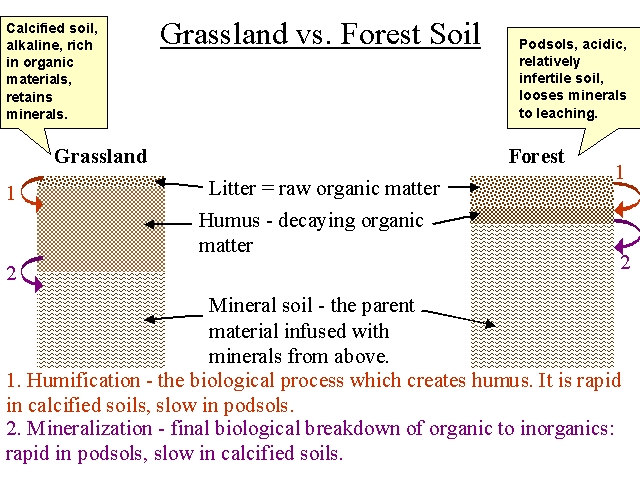SOIL SYSTEMS
by
Mrs. Eilisha Joy Bryson
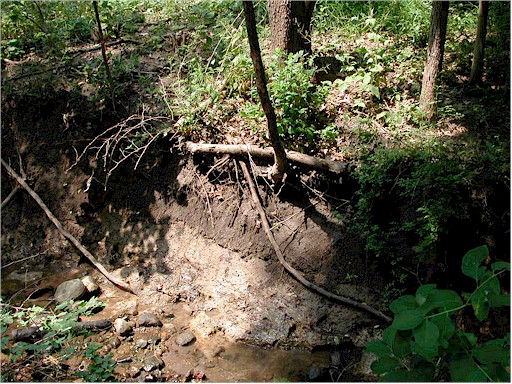 http://www.co.kane.il.us/kcstorm/raceway/images/precon/soilhrzn.jpg
http://www.co.kane.il.us/kcstorm/raceway/images/precon/soilhrzn.jpg
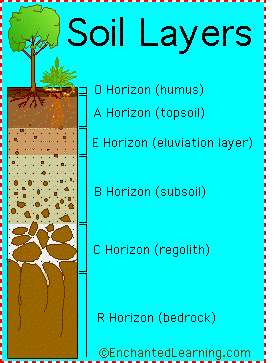
Soil is a complex and dynamic system
that whose composition and maintenance is importance to plants, microorganisms,
water quality, and many other things, including humans. Pedologists in
the United States have classified soil into 12 taxonomic groups.
This web page compares two of these groups, mollisols and spodsols.
Each soil within a group is slightly different yielding a different
vegetation perhaps, but all
soils have several layers, or horizons that can be observed in
most cases (see diagrams).
http://www.enchantedlearning.com/geology/soil/soillayers.GIF
Soils and Vegetation
http://jimswan.com/111/soil/soils.jpg
Mollisol
The first example discussed will be mollisol.
This system is predominantly known for supporting grasslands, and
claims 7% of the world ice-free land. In America, mollisol is 21% of
the land. Mollisol exists in certain climates of semi-arid to
semi-humid, which are found in middle latitude regions (see U.S. map).
This soil is soft and granular.
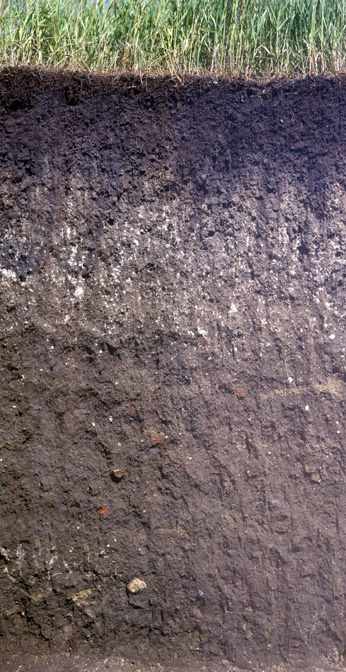
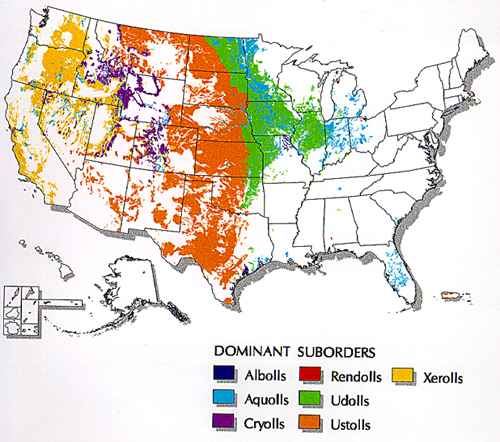 This picture shows actual mollisol. The A horizon of the mollisol is
called mollic epipedon. It consists of organic matter making it
rich and very fertile. Dead plant material constantly replenishes this
topsoil layer maintaining the organic characteristic. The soil in this
top section is very dark and thick. The B horizon consists of clay from
the weathering of its parent material, which leads to the C
horizon. The parent rock of mollisol is limestone, loess, or
wind-blown sand. This parent material gives mollisol its basic pH
characteristic. Gardeners often treat their lawns or gardens with a
fine powder to balance the pH levels of their land if it is too acidic.
They are mimicking what naturally happens in mollisol. The fine powder
is ground limestone, and is used to make your land more basic, which
many plants prefer.
This picture shows actual mollisol. The A horizon of the mollisol is
called mollic epipedon. It consists of organic matter making it
rich and very fertile. Dead plant material constantly replenishes this
topsoil layer maintaining the organic characteristic. The soil in this
top section is very dark and thick. The B horizon consists of clay from
the weathering of its parent material, which leads to the C
horizon. The parent rock of mollisol is limestone, loess, or
wind-blown sand. This parent material gives mollisol its basic pH
characteristic. Gardeners often treat their lawns or gardens with a
fine powder to balance the pH levels of their land if it is too acidic.
They are mimicking what naturally happens in mollisol. The fine powder
is ground limestone, and is used to make your land more basic, which
many plants prefer.
Agriculturally, mollisol is
highly valued. It is the soil that produces many crops and vegetation.
For example, soybeans, corn, sorghum, and small grains are all
cultivated with this soil system. This fertility of this soil equates
it with being a good soil ecosystem, and having the characteristics of
a typical soil environment. The organisms within the soil are
well-established and are at optimal levels of survival. This means that
bacteria are flourishing and helping to maintain the crops that grow
within this system. They are the primary decomposes, providing vital
nutrients, such as nitrogen, to the plants and other organisms. The
bacteria in this system maintain a ratio of about 1:1 with fungi. Their
predators, nematodes, some fungi, earthworms and arthropods, are also
in the soil.
http://soils.usda.gov/technical/soil_orders/
http://soils.usda.gov/technical/classification/orders/mollisols_map.html
Spodsols or podsol is yet another
example of a soil system. This system is predominately located in cool,
moist coniferous forests. It only makes up about 4% of the world's
ice-free land. It is about 4% of the American soil as well. They can be
found around the Northern belt on a world map, coinciding with
coniferous forests (see U.S. map).
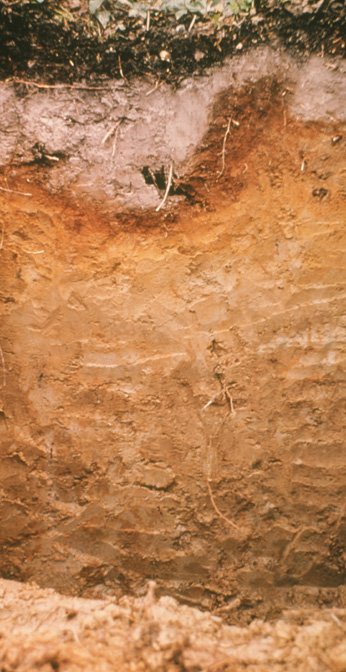
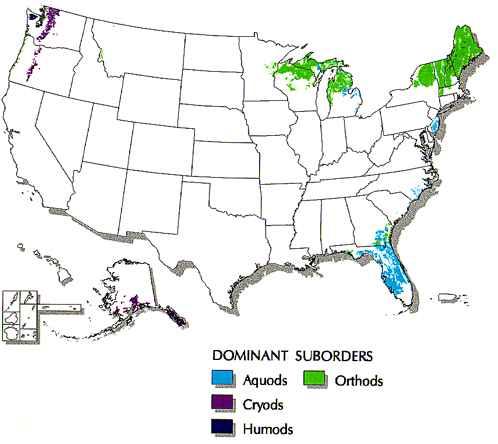 This picture shows actual spodsols.
The A horizon of spodsols is what gives this soil its name. It is ash-gray in color, or ash-like, the
Russian meaning of podsol. This lack of color comes from the
environmental weathering that takes place in this environment. The A
horizon is very acidic and bleaches or leaches the clay, iron, and
aluminum from the soil. This acid levels come from the calcium in the
needles of the carnivorous trees. Water moves through the system at a
much higher rate than it evaporates and washes the acidic material into
the soil, carrying away the clay, iron, and aluminum. This process
leaves behind quartz sand and silica. In the B horizon, predisposition
of the iron occurs forming a impermeable layer, blocking water and
roots from moving downward any further. This layer is made from
orange-brown to reddish-brown clay. These layers are distinct most of
the time due to the lack of burrowing organisms, such as the earthworm.
This picture shows actual spodsols.
The A horizon of spodsols is what gives this soil its name. It is ash-gray in color, or ash-like, the
Russian meaning of podsol. This lack of color comes from the
environmental weathering that takes place in this environment. The A
horizon is very acidic and bleaches or leaches the clay, iron, and
aluminum from the soil. This acid levels come from the calcium in the
needles of the carnivorous trees. Water moves through the system at a
much higher rate than it evaporates and washes the acidic material into
the soil, carrying away the clay, iron, and aluminum. This process
leaves behind quartz sand and silica. In the B horizon, predisposition
of the iron occurs forming a impermeable layer, blocking water and
roots from moving downward any further. This layer is made from
orange-brown to reddish-brown clay. These layers are distinct most of
the time due to the lack of burrowing organisms, such as the earthworm.
Spodsol is the
soil found in forests, but it is infertile due to the levels of
acidity. This is supported by the lack of earthworms present in this
soil since earthworms indicate a healthy grade of soil. The plants in
this ecosystem do live. This system includes organisms that have
adaptive characteristics to withstand the pH levels and climate
characteristics. Fungi play a major role in forest ecosystems as
decomposes and mutualists. They take on the role of bacteria, breaking
down the essential nutrients into a form that can be used by other
organisms. They are crucial to the survival pf plants here and form
mycorrizal living arrangements in this environment. The ratio of the
biomass of fungi to bacteria in a coniferous forest system is 100:1 to
1000:1. The bacteria are not adaptive to survive under these
conditions, so the fungi fills this niche.
http://soils.usda.gov/technical/soil_orders/
http://soils.usda.gov/technical/classification/orders/spodosols_map.html
Spodsol and
MollisolThese
two soil systems, by function, have many things in common. Both systems
have the characteristics necessary to sustain plant life, and therefore
organism life as well. They both have topsoil layers that are composed
of material that allows the plants to firmly establish their root
systems and to maintain growth. In addition to the soil being a major
component of plant growth, both systems have maintained an ecosystems
that includes decomposes to help cycle essential nutrients to the
organisms.
The differences between the soil are perhaps more interesting. All soil
is not the same, and these two examples show great evidence of this.
The most obvious upon first glance would be the type of plant life each
supports; spodsol sustaining large forest trees and mollisol supporting
low grasslands. This is due to the climatic differences in each system.
The spodsol is very wet and cold. Other flowering and deciduous trees
cannot live under these conditions. Pollinators cannot live under these
conditions and deciduous trees do not have enough protection against
the temperatures. In the mollisol system, the humid, dry c conditions
would not be able to support thirst trees. The plantlife an ecosystem
can sustain is the result of the characteristics that each system has.
The most interesting difference to me between the spodsol and mollisol
systems is the difference in pH levels. The podsol is very acidic due
to the chemicals within the coniferous tree needles. This is
fascinating because that affects which organisms can survive in this
soil. In the mollisol
system, the high
pH levels produce fertile land with bacteria being the primary
decomposer. Here, the normal ratio of bacteria to fungi is 1:1. In thee spodsol, fungi fill the
niche that bacteria normally hold because they can tolerate the acidic
conditions, whereas bacterias cannot. I, fanatically different from the
100:1 to 1000:1 relationship in the acidic soil. Trees are dependent on
the mycorriza for nutrient intake. The pH levels within the ecosystems
affect the role that organisms fulfill, sometimes filling unexpected
niches..
In addition to the pH and plant species that differ in the spodsol
and mollisol systems, this chart shows several other differences:
http://jimswan.com/111/soil/soil_profiles.jpg
References:
http://soils.usda.gov/technical/classification/orders/mollisols.html
http://soils.usda.gov/technical/soil_orders/
http://www.eais.net/soil/
http://www.enviroliteracy.org/subcategory.php/36.html
http://www.geography.btinternet.co.uk/pine.htm#Podsol%20soil%20profile
http://www.pupilvision.com/uppersixth/soiltypes.htm


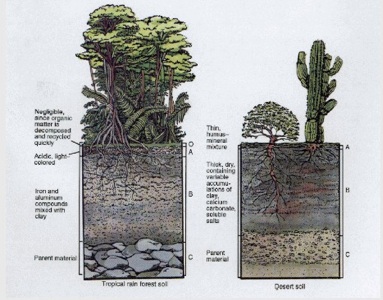
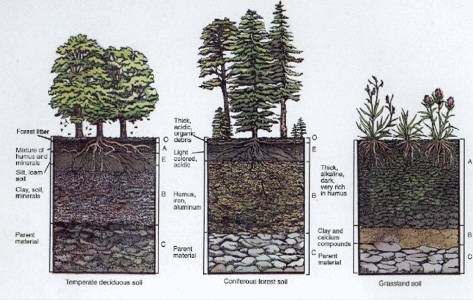

 This picture shows actual mollisol. The A horizon of the mollisol is
called mollic epipedon. It consists of organic matter making it
rich and very fertile. Dead plant material constantly replenishes this
topsoil layer maintaining the organic characteristic. The soil in this
top section is very dark and thick. The B horizon consists of clay from
the weathering of its parent material, which leads to the C
horizon. The parent rock of mollisol is limestone, loess, or
wind-blown sand. This parent material gives mollisol its basic pH
characteristic. Gardeners often treat their lawns or gardens with a
fine powder to balance the pH levels of their land if it is too acidic.
They are mimicking what naturally happens in mollisol. The fine powder
is ground limestone, and is used to make your land more basic, which
many plants prefer.
This picture shows actual mollisol. The A horizon of the mollisol is
called mollic epipedon. It consists of organic matter making it
rich and very fertile. Dead plant material constantly replenishes this
topsoil layer maintaining the organic characteristic. The soil in this
top section is very dark and thick. The B horizon consists of clay from
the weathering of its parent material, which leads to the C
horizon. The parent rock of mollisol is limestone, loess, or
wind-blown sand. This parent material gives mollisol its basic pH
characteristic. Gardeners often treat their lawns or gardens with a
fine powder to balance the pH levels of their land if it is too acidic.
They are mimicking what naturally happens in mollisol. The fine powder
is ground limestone, and is used to make your land more basic, which
many plants prefer.
 This picture shows actual spodsols.
The A horizon of spodsols is what gives this soil its name. It is ash-gray in color, or ash-like, the
Russian meaning of podsol. This lack of color comes from the
environmental weathering that takes place in this environment. The A
horizon is very acidic and bleaches or leaches the clay, iron, and
aluminum from the soil. This acid levels come from the calcium in the
needles of the carnivorous trees. Water moves through the system at a
much higher rate than it evaporates and washes the acidic material into
the soil, carrying away the clay, iron, and aluminum. This process
leaves behind quartz sand and silica. In the B horizon, predisposition
of the iron occurs forming a impermeable layer, blocking water and
roots from moving downward any further. This layer is made from
orange-brown to reddish-brown clay. These layers are distinct most of
the time due to the lack of burrowing organisms, such as the earthworm.
This picture shows actual spodsols.
The A horizon of spodsols is what gives this soil its name. It is ash-gray in color, or ash-like, the
Russian meaning of podsol. This lack of color comes from the
environmental weathering that takes place in this environment. The A
horizon is very acidic and bleaches or leaches the clay, iron, and
aluminum from the soil. This acid levels come from the calcium in the
needles of the carnivorous trees. Water moves through the system at a
much higher rate than it evaporates and washes the acidic material into
the soil, carrying away the clay, iron, and aluminum. This process
leaves behind quartz sand and silica. In the B horizon, predisposition
of the iron occurs forming a impermeable layer, blocking water and
roots from moving downward any further. This layer is made from
orange-brown to reddish-brown clay. These layers are distinct most of
the time due to the lack of burrowing organisms, such as the earthworm.
